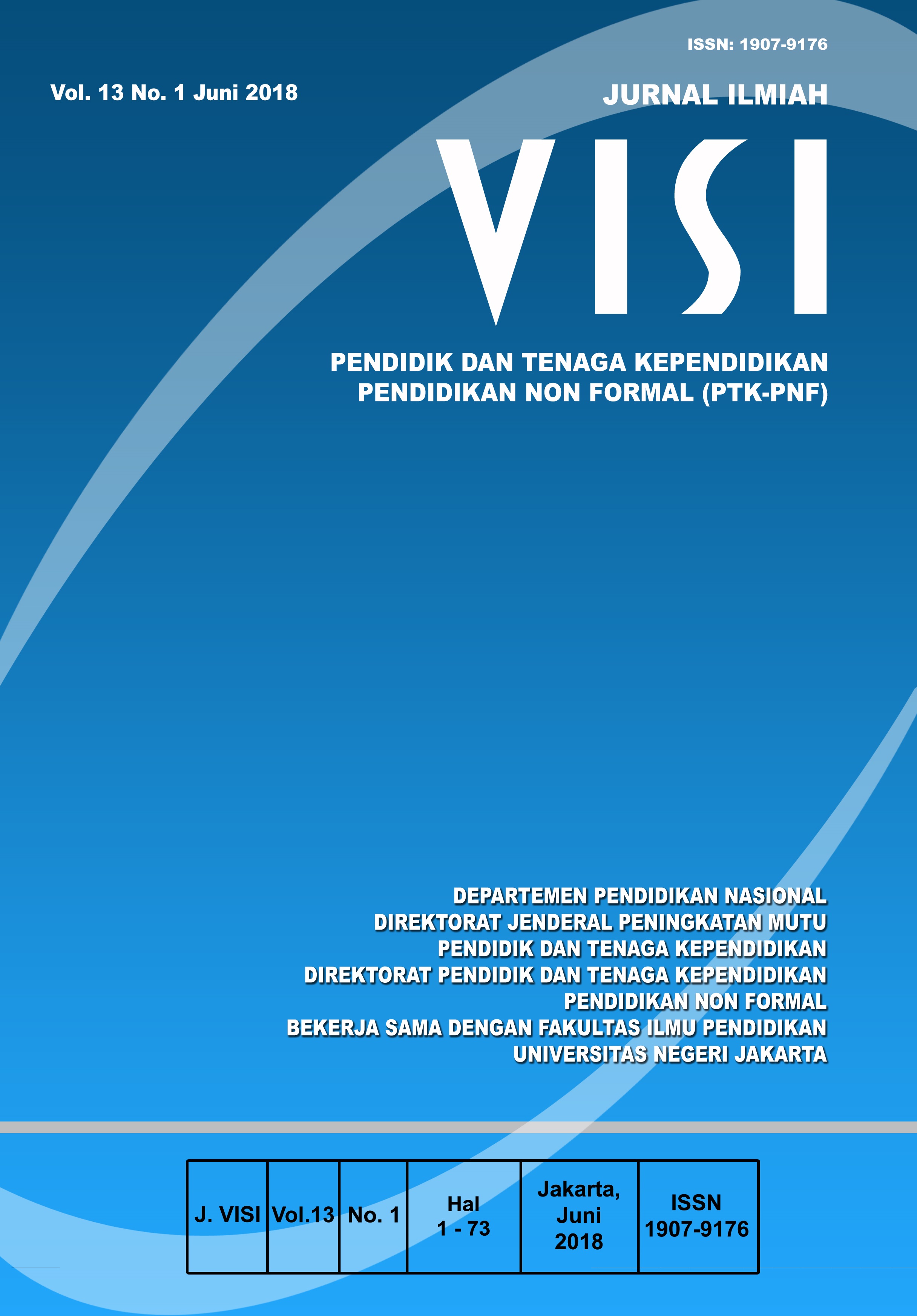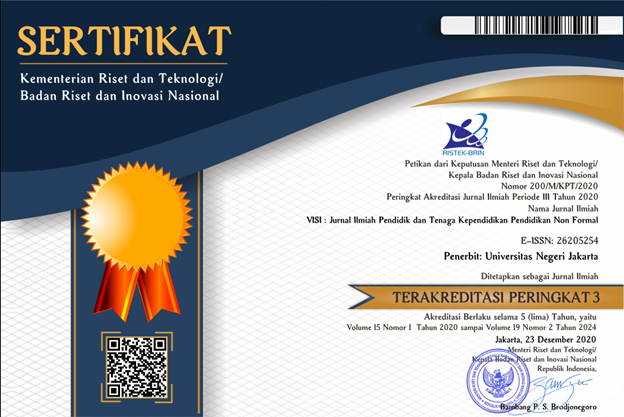PROFIL KREATIVITAS ANAK USIA 5-6 TAHUN
DOI:
https://doi.org/10.21009/JIV.1301.2Keywords:
5-6 years children creativity, student-based learning and teacher-centered learning modelAbstract
This study aims to determine the level of child creativity and the effectiveness of various models of learning in early-childhood in developing the creativity of children aged 5-6 years after the city of Serang, Banten. The research was conducted from April to July 2017. The research method used was the mixed method with the research population is all children aged 5-6 years in Serang city, Banten. The sample was 120 children from 30 PAUD institutions, consisting of two groups, which were 60 children from early-childhood with teacher-centered learning model and 60 children from PAUD with student-based learning model. The results showed that the creativity level of children aged 5-6 years in Serang city is categorized as high and there is no significant difference of creativity of children aged 5-6 years after the model of student-based learning with teacher-centered learning model. However, the level of creativity of children with student-based learning model is higher than the teacher-centered learning model. This study concludes that student-based learning model (center, area, group, or angle) is more effective in developing the creativity of children aged 5-6 years. Recommendations for institutions, communities, stakeholders, and researchers are further discussed within the article.
References
Depdikbud. (2014). Permendikbud nomor 146 Tahun 2014 tentang kurikulum 2013 pendidikan anak usia dini. Jakarta: Kemendikbud.
Fauzi. (2016). Pembentukan karakter anak melalui permainan tradisional cim-ciman. Jurnal Ilmiah Visi, 11(2), 99-110. doi: https://doi.org/10.21009/JIV.1102.4
Kartadinata, S. (2012). Memantapkan karakter bangsa menuju generasi 2045. Seminar Nasional Peringatan Hari Guru, 25 November 2012.
Kasjono, H. S. & Yasril. (2009). Teknik sampling untuk penelitian kesehatan. Yogyakarta: Graha Ilmu.
Kusumawardani, R. (2015). Peningkatan kreativitas melalui pendekatan brain based learning. Jurnal Pendidikan Usia Dini, 9(1), 143-162. doi: https://doi.org/10.21009/JPUD.091.09
Nurhayati. (2008). Studi perbandingan metode sampling antara simple random dengan stratified random. Jurnal Basis Data, 3(1), 18-32. http://old.unas.ac.id/download.php?file=Basis_Data_Vol_3_No_1_2008_list3.pdf
Hamalik, O. (2005). Proses belajar mengajar. Bandung: PT. Remaja Rosdakarya.
Rawat, A. (2016). Assessing the needs of the learner through maslow’s model of self-actualization. The International Journal of Humanities & Social Studies, 4(10), 132-135. http://theijhss.com/2016-2/october-16
Runco, M.A. (1988). Creativity research: originality, u t i l i t y, and integration. Creativity Research Journal, 1(1), 1-7. doi: http://dx.doi.org/10.1080/10400418809534283
Runco, M.A., & Jaeger, G.J. (2012). The standard definition of creativity. Creativity Research Journal, 24(1,) 92-96. doi: http://dx.doi.org/10.1080/10400419.2012.650092
Sadiman, A.S. (1990). Media pendidikan, pengertian, pengembangan, dan pemanfaatannya. Jakarta: CV Rajawali.
Sternberg, R. J. (2006). The nature of creativity. Creativity Research Journal, 18(1), 87-98. doi: http://dx.doi.org/10.1207/s15326934crj1801_10
Wilma, V., et al. (2000). Handbook on child development. Australia: Social Science Press.
Downloads
Published
How to Cite
Issue
Section
License
Authors who publish with this Journal agree to the following terms:
- Author retain copyright and grant the journal right of first publication with the work simultaneously licensed under a creative commons attribution licensethat allow others to share the work within an acknowledgement of the work’s authorship and initial publication of this journal.
- Authors are able to enter into separate, additional contractual arrangementfor the non-exclusive distribution of the journal’s published version of the work (e.g. acknowledgement of its initial publication in this journal).
- Authors are permitted and encouraged to post their work online(e.g. in institutional repositories or on their websites) prior to and during the submission process, as it can lead to productive exchanges, as well as earlier and greater citation of published works.
- Users/public use of this website will be licensed to CC BY-NC-SA Creative Commons Attribution-NonCommercial-ShareAlike 4.0 International License









